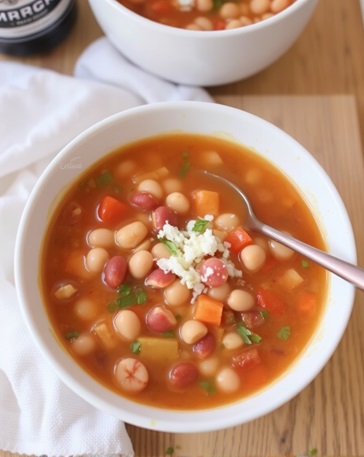In this article, we’ll explore the many benefits of soups, offer tips for preparing them, and dive into some delicious, easy-to-make soup recipes that can boost your health while warming your soul.
Nothing beats a steaming bowl of hearty soup on a cold day—or even a warm one! Soups are the perfect comfort food that not only satisfies your taste buds but also nourishes your body.
Whether you’re looking for a quick meal after a long day, a low-calorie option, or a nutrient-packed dish, soups offer a versatile and healthy solution.
Soup Basics
Soup can be made from nearly any combination of ingredients, making it one of the most adaptable dishes. There are two main types of soups—broth-based and creamy. Broth-based soups tend to be lower in calories and fat, making them ideal for those on a low-calorie diet, while creamy soups are heartier and provide a more indulgent flavor.
Essential Ingredients for Healthy Soup Recipes:
- Vegetables: A soup’s primary source of nutrients, providing vitamins, minerals, and antioxidants.
- Broth or Stock: Whether it’s vegetable, chicken, or beef stock, the base of the soup determines its flavor profile. (You may find out how to prepare broth for soup below)
- Protein: Chicken, beans, lentils, and tofu are excellent sources of protein that can be added to soup for satiety and muscle-building.
- Grains: Rice, quinoa, and barley can make soups more filling and add texture.
- Herbs and Spices: Garlic, ginger, thyme, and turmeric enhance flavor and provide added health benefits.
Making your soup at home means you have control over the ingredients, allowing you to limit sodium, fats, and preservatives commonly found in store-bought options. You can make your soups as nutrient-dense or as indulgent as you’d like while keeping them within your dietary preferences.
Benefits of Soups
Soups aren’t just comforting; they offer a host of health benefits, making them an excellent addition to your daily meal plan.
Supports Weight Loss
Most soups, especially broth-based ones, are naturally low in calories and high in water content. This keeps you feeling full and hydrated, reducing the likelihood of overeating. Replacing higher-calorie meals with healthy soup ideas can support weight loss goals without sacrificing satisfaction.
Boosts Immunity
Soups, especially those rich in vegetables, garlic, ginger, and turmeric, contain immune-boosting properties. Ingredients like chicken broth and mushrooms also help strengthen your body’s defenses, keeping illnesses like colds and flu at bay.
Improves Digestion
Soups are easy to digest and soothing for the digestive system. Fiber-rich vegetables in soups promote healthy bowel movements, while bone broth can help repair the gut lining.
Keeps You Hydrated
Soups are an excellent way to increase your fluid intake. The combination of water and nutrient-dense ingredients ensures you stay hydrated, which is key for maintaining energy levels and supporting overall health.
Nutrient-Dense
When you make a soup packed with vegetables, lean proteins, and whole grains, you’re getting a balanced meal that provides essential vitamins, minerals, and antioxidants. These nutrients promote heart health, improve skin health, and support overall well-being.
Read more:
15 Soup Recipes with Steps & Benefits
1. Vegetable Broth Cleanse Soup

Steps:
- Sauté onions, garlic, and carrots.
- Add water and a variety of chopped vegetables.
- Simmer for 30 minutes, season with herbs and spices.
- Blend or serve as is.
Benefits: Promotes detoxification, improves digestion, and keeps calories low while delivering a variety of essential vitamins and minerals.
2. Chicken Ginger Healing Soup

Steps:
- Cook chicken pieces in a pot with garlic and ginger.
- Add broth and vegetables like carrots and celery.
- Simmer for 40 minutes.
- Remove chicken, shred, and return to pot.
Benefits: Boosts the immune system, reduces inflammation, and aids in recovery from colds or flu.
3. Spicy Detox Soup

Steps:
- Sauté garlic, ginger, and chili peppers.
- Add tomatoes, vegetable broth, and kale.
- Simmer for 25 minutes.
- Serve with a squeeze of lime.
Benefits: Cleanses the body, supports weight loss, and reduces bloating due to high fiber content.
4. Immune Boosting Mushroom Soup

Steps:
- Cook mushrooms in olive oil until soft.
- Add garlic, onions, and broth.
- Simmer for 20 minutes, and blend if desired.
- Add parsley for extra antioxidants.
Benefits: High in antioxidants, strengthens immune function, and supports healthy digestion.
5. High-Protein Lentil Soup

Steps:
- Sauté onions and carrots, add lentils.
- Pour in vegetable broth and seasonings.
- Simmer for 35 minutes.
- Add spinach and serve.
Benefits: Great source of plant-based protein, stabilizes blood sugar, and promotes heart health.
6. Creamy Butternut Squash Soup (Dairy-Free)

Steps:
- Roast butternut squash until soft.
- Blend with sautéed onions, garlic, and vegetable broth.
- Add coconut milk for creaminess.
- Simmer for 10 minutes.
Benefits: Rich in vitamins A and C, supports eye health, and improves skin elasticity.
7. Bone Broth Collagen Soup

Steps:
- Slow-cook beef or chicken bones for 24 hours.
- Strain broth and add fresh vegetables.
- Simmer for 20 minutes and serve.
Benefits: Supports joint health, improves gut lining, and boosts collagen production.
8. Quick Egg Drop Soup

Steps:
- Boil chicken broth with ginger and soy sauce.
- Slowly pour in whisked eggs while stirring.
- Garnish with green onions and serve.
Benefits: Rich in protein, low in calories, and supports muscle repair.
9. Turmeric Anti-Inflammatory Soup

Steps:
- Sauté onions, garlic, turmeric, and ginger.
- Add broth and your favorite vegetables.
- Simmer for 30 minutes and blend.
Benefits: Reduces inflammation, supports brain health, and improves digestion.
10. Fiber-Packed Bean Soup

Steps:
- Sauté onions and garlic, and add beans and broth.
- Simmer for 30 minutes.
- Add kale and seasonings, simmer for 5 more minutes.
Benefits: High in fiber for digestive health, stabilizes blood sugar and supports weight loss.
11. Low-Carb Cauliflower Soup

Steps:
- Roast cauliflower with olive oil.
- Blend with garlic, onions, and broth.
- Simmer for 10 minutes, add cream if desired.
Benefits: Great for low-carb diets, supports weight loss and reduces inflammation.
12. Heart-Healthy Tomato Basil Soup

Steps:
- Roast tomatoes and blend with sautéed onions and garlic.
- Add broth and fresh basil.
- Simmer for 15 minutes and serve.
Benefits: Packed with antioxidants like lycopene, supports heart health and improves skin health.
13. Healing Garlic Soup

Steps:
- Roast whole garlic cloves until caramelized.
- Blend with broth and onions.
- Simmer for 20 minutes and season with herbs.
Benefits: Antibacterial, boosts immune function, and helps detoxify the body.
14. Weight Loss Cabbage Soup

Steps:
- Sauté onions, garlic, and carrots.
- Add chopped cabbage, tomatoes, and broth.
- Simmer for 30 minutes.
- Season and serve.
Benefits: Low in calories, high in fiber, and promotes satiety.
15. Gut-Healing Miso Soup

Steps:
- Heat water, and dissolve miso paste.
- Add tofu, seaweed, and green onions.
- Simmer for 5 minutes and serve.
Benefits: Supports gut health, is rich in probiotics, and aids digestion.
How to Prepare Broth for Soup
A good broth is the foundation of any great soup, and making it from scratch adds an unmatched depth of flavor. Homemade broth is healthier than store-bought versions, as it’s free from preservatives and excessive sodium. Here’s how you can prepare a nutritious, flavorful broth that will enhance any soup recipe.
Ingredients:
- Bones or Vegetables: Use chicken, beef, or fish bones for meat-based broth, or a variety of vegetables for a plant-based version.
- Aromatics: Onions, garlic, celery, carrots, and leeks add flavor and nutrients.
- Herbs and Spices: Fresh herbs like thyme, parsley, and bay leaves, plus a few peppercorns.
- Water: Enough to cover all ingredients.
Steps:
- Prepare Your Ingredients: For a rich broth, roast bones in the oven at 400°F (200°C) for about 30 minutes to deepen their flavor. If making vegetable broth, chop your vegetables into large chunks.
- Simmer Ingredients: Add bones or vegetables, aromatics, and herbs to a large pot. Cover with water, bring to a boil, then reduce heat to a gentle simmer.
- Skim the Surface: If using bones, skim off any foam that rises to the surface in the first hour of cooking. This keeps the broth clear.
- Cook Slowly: Let the broth simmer for at least 4 hours for vegetable broth and 8–24 hours for bone broth. The longer it cooks, the richer the flavor and nutrients.
- Strain and Store: Once the broth is done, strain it through a fine mesh sieve or cheesecloth to remove solids. Let it cool, then refrigerate or freeze it in portions for future use.
Tips:
- Add Vinegar: When making bone broth, add 1–2 tablespoons of vinegar (like apple cider vinegar) to help extract minerals like calcium and magnesium from the bones.
- Don’t Over-Salt: Hold off on adding salt while cooking the broth, as you can season it later when making soup to avoid oversalting.
- Freeze for Convenience: Freeze broth in ice cube trays or airtight containers for easy portioning and long-term storage.
Homemade broth adds depth to your soup recipes, enhances nutrients, and offers a healthier alternative to store-bought varieties.
Tips to Prepare Soup Recipes
Preparing delicious soups doesn’t require advanced cooking skills. Here are some tips to ensure your soups are not only flavorful but also packed with health benefits.
- Use Homemade Broth: Opt for homemade chicken or vegetable broth instead of store-bought versions to control sodium levels and enhance flavor. You can easily make broth by simmering bones and vegetables in water for a few hours.
- Season Gradually: Start with less seasoning and taste as you go. Herbs like thyme, parsley, and rosemary can add freshness and complexity without the need for excess salt.
- Blend for Creaminess: For creamy soups without the added calories from heavy cream, try blending a portion of the soup with ingredients like potatoes, squash, or cauliflower to create a smooth, rich texture.
- Add Healthy Fats: A drizzle of olive oil, a spoonful of coconut milk, or even some avocado can give your soup a delicious finish while adding heart-healthy fats.
- Batch Cook and Freeze: Soups are perfect for meal prep! Make a large batch and freeze it in individual portions. This makes it easy to have quick, ready soup for dinner on busy nights.
- Incorporate Superfoods: Boost the nutrient content of your soups by incorporating immune-boosting ingredients like garlic, ginger, kale, and turmeric. These superfoods help combat inflammation and support overall health.
Conclusion
Soups are a culinary staple that can be easily tailored to suit any dietary preference or lifestyle. Whether you’re looking for a quick dinner recipe, an immune-boosting meal, or a low-calorie dish, soup is the perfect solution. Packed with nutrients and flavor, these hearty soup recipes are easy to make and offer a comforting way to stay healthy year-round. So grab your favorite pot, chop up some veggies, and get ready to enjoy a bowl of delicious, soul-warming soup!


